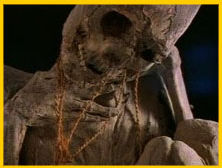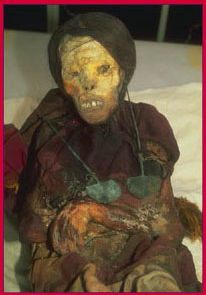 |
 |
 |
 Mummies of the World
Mummies of the WorldPart 2 (back to Part 1) Early South American and Inca mummies While the ancient Egyptians may be the best-known mummy makers, they were far from the first. A very sophisticated fishing tribe called the Chinchoros, who lived on the north coast of what is now Chile, were embalming their dead as early as 5000 B.C. Chinchoros embalmers disassembled their corpses, treated the internal organs to prevent decay, and then reassembled the pieces. They often added cane or wood supports along the spinal column, arms and legs, filled in the body cavity with fiber or feathers, and coated the exterior of the body with clay, on which they painted or sculpted. Infants, children and adults of both sexes were mummified, though some corpses received more attention than others. Further north, another coastal group at Paloma were mummifying their dead as early as 4000 B.C. The Palomans used salt to stop decay and carefully positioned their dead with knees drawn to the chest and hands clasped. The bodies were then wrapped in reed matting and buried under the floor of their existing homes. By the time of the Inca civilization, which lasted from approximately 1100 to 1500 A.D., the Andean tradition of preserving the dead was still intact. Most Inca mummies were arranged in the familiar fetal position and were either wrapped in leather or cloth, or placed in baskets or under huge ceramic jars. These "mummy bundles" were often brightly decorated and buried with food, clothing and other items. Some archaeologists believe that the Inca mummified all their dead, not just the elite. When the Spanish conquered the Inca in the 1500's and 1600's, they forbade the practice of mummification, declaring it pagan. The Spanish destroyed countless Incan burial sites—partly for religious reasons, but also to plunder the gold often buried with mummies. As a result, few Incan burial sites remain.  In 1875, archaeologists did manage to uncover a huge burial site at
Ancón on the Peruvian coast. Hundreds of shafts, some eighteen to
twenty feet deep, led to tombs where extremely well-preserved mummies bundles
were found. Apparently, the dry climate and high salt content of the region
had helped to prevent decay. The mummies were wrapped in cloth, seaweed,
leaves, grass matting and furs. Many bundles were topped with a sort of false
head, decorated with eyes that stared out into the darkness of the tomb.
In 1875, archaeologists did manage to uncover a huge burial site at
Ancón on the Peruvian coast. Hundreds of shafts, some eighteen to
twenty feet deep, led to tombs where extremely well-preserved mummies bundles
were found. Apparently, the dry climate and high salt content of the region
had helped to prevent decay. The mummies were wrapped in cloth, seaweed,
leaves, grass matting and furs. Many bundles were topped with a sort of false
head, decorated with eyes that stared out into the darkness of the tomb. Perhaps the most remarkable Incan mummies have been those found on high mountain peaks, where the Inca offered human sacrifices to their Gods. Over the years, some 115 of these sacrificial mummies have been found in the high Andes. In 1995, Dr. Johan Reinhard stumbled upon the body of a young girl, barely into her teens, on top of Mount Ampato in the Peruvian Andes. Named "Juanita," she is the best-preserved Incan mummy ever discovered. With long black hair, a graceful neck, and well-muscled arms, Juanita was found wrapped in a cocoon of fine textiles and surrounded by gold and silver statues, bags of corn and other offerings. The goal of this, Reinhard's latest expedition, is to locate more of these mummies and expand our understanding of Incan sacrificial rites. Continue Photos: (2) courtesy The Mountain Institute. Expedition '96 | Dispatches | Mummies | Lost Worlds | Mail Resources | Site Map | Ice Mummies of the Inca Home | BBC Horizon Editor's Picks | Previous Sites | Join Us/E-mail | TV/Web Schedule About NOVA | Teachers | Site Map | Shop | Jobs | Search | To print PBS Online | NOVA Online | WGBH © | Updated November 2000 |